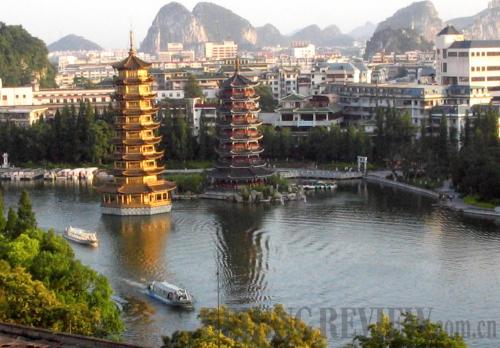|
 |
|
FAVORABLE RESIDENCE: Guilin, southwest China's Guangxi Zhuang Autonomous Region, leads others in creating a pleasant residential environment by strictly controlling pollution (XINHUA) |
A forum addressing science and technological innovations and the future of urbanization was held in Wuxi City in east China's Jiangsu Province on June 21-22, where scientists and government officials the world over discussed these three main issues. Edited excerpts follow:
Health
Barry J. Marshall (professor of clinical medicine at the University of Western Australia and Nobel Laureate in Physiology or Medicine 2005)
The world has benefited from new discoveries in treating diseases and the ability of those in the science community to put this new knowledge to applicable use. Mankind has reaped these benefits by controlling their environment, and the easiest way to do that is to live in cities where the food and water is clean, where everyone becomes a specialist, and new sanitation projects facilitate healthier living.
In 2008, the world celebrated the 100th anniversary of the invention of chlorination, the process that kills germs and helps produce clean drinking water. In the 20th century, our understanding of infectious diseases and the discovery of many antibiotics have allowed us to control most common diseases and expect a safer and longer life.
But we learned some painful lessons from SARS (severe acute respiratory syndrome) in 2003. The outbreak reminded us that some epidemics can come from animals and we must separate humans from their waste products. It also showed the importance of vaccinating the population. Vaccines are now the second line of defense in the event that city clinics become overwhelmed or shut down.
Modern technologies allow us to quickly respond to urgent epidemics and give an early warning about what is happening. For example, many people around the world use social networking tools like Twitter, which makes it easier to spread information about diseases. As we live longer and have more enjoyable lives, we will have to worry about cancer, arthritis and other diseases associated with old age. This enhances the need for new materials, artificial organs or vaccines to fight viruses and diseases.
Transportation
Colin Stacey (Principal Administrator of the International Transport Forum)
Vehicle ownership will grow rapidly in most parts of the world, India and China in particular. The increase reflects a boom in urban prosperity, but will also mount intense pressure on urban transport systems. Traffic congestion and pollution are already having a negative impact on cities and will blossom into bigger problems with a bigger number of cars on city streets.
Resolving these problems will be far from easy and will involve vigorous efforts in two major areas. The first is to develop green vehicles that help save energy and limit pollution. The second is to make full use of the transport network capacity. This is an area where modern technologies could play a significant role. For example, many cities are building intelligent transport systems based on advanced information and communication technologies. The systems can provide real-time traffic information for drivers to make decisions about routes and parking sites.
Science and technology have an extremely important role in the urban transport system, and is expected to be a facilitator for the systems to become more sustainable. There are many other advanced technologies available, but most are yet to be fully effective due to a lack of policy coordination, planning and efficient governance. For instance, different transport services like buses, railways and ships have their own networks, and there is little connection between them. So the policymakers need to think about how to link the different networks and provide better services.
Underground
Qian Qihu (professor with the PLA University of Science and Technology and academician of the Chinese Academy of Engineering)
Joseph Stiglitz, a Nobel laureate in economics, predicted that China's urbanization and the information technology led by the United States are the two key factors that will affect human progress in the 21st century. China's rapid urbanization, however, has given rise to many problems, including traffic congestion, accidents and public security concerns that public transportation systems might be targeted by terrorists.
To tackle these problems, we must set a greener course for our future urban and intercity transportation. Among the most creative and phenomenal solutions is the underground maglev transport system. Using magnetic levitation from a large number of magnets for lift and propulsion, the maglev trains are more energy-efficient and environment friendly than traditional vehicles.
In addition, more expressways will also be built underground. The waste gas can be easily eliminated with static electricity. Most importantly, this saves space aboveground, soothing concerns over land shortages.
Many countries have already put efforts into researching and developing underground transport networks. Guangzhou, capital of south China's Guangdong Province, is building an underground vacuum pipe network to collect waste for the 2010 Asian Games Village. Tokyo, Japan, also plans to build a vast underground logistics transport system. It is estimated the system could reduce energy consumption in Tokyo by 18 percent and lift the speed of cargo transport by 24 percent.
| 